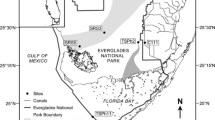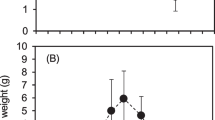Abstract
The characteristics of gas exchange and carbon isotope discrimination were determined for a number of lichen species, representing contrasting associations between fungal (mycobiont) and photosynthetic (photobiont) organism. These parameters were evaluated with regard to the occurrence of any CO2-concentrating mechanism (CCM) expressed specifically by the green algal (phycobiont) or cyanobacterial (cyanobiont) partner. Carbon isotope discrimination (Δ) fell into three categories. The highest Δ, found in lichens comprising a phycobiont plus cyanobacteria limited to pockets in the thallus (known as cephalodia), ranged from 24 to 28‰, equivalent to a carbon isotope ratio (δ13C) of around -32 to-36‰ vs. Pee Dee Belemnite (PDB) standard. Further evidence was consistent with CO2 supply to the carboxylating system entirely mediated by diffusion rather than a CCM, in that thallus CO2 compensation point and online instantaneous Δ were also high, in the range normally associated with C3 higher plants. For lichens consisting of phycobiont or cyanobiont alone, organic material Δ formed two distinct ranges around 15‰ (equivalent to a δ13C of -23%.). Thallus compensation point and instantaneous Δ were lower in the cyanobiont group, which also showed higher maximum rates of net photosynthesis, whether expressed on the basis of thallus dry weight, chlorophyll content or area. These data provide additional evidence for the activity of a CCM in cyanobiont lichens, which only show photosynthetic activity when reactivated with liquid water. Rates of net CO2 uptake were lower in both phycobiont associations, but were relatively constant across a wide working range of thallus water contents, usually in parallel with on-line Δ. The phycobiont response was consistent whether photosynthesis had been reactivated with liquid water or water vapour. The effect of diffusion limitation could generally be seen with a 3–4‰ decrease in instantaneous Δ at the highest water contents. The expression of a CCM in phycobiont algae, although reduced compared with that in cyanobacteria, has already been related to the occurrence of pyrenoids in chloroplasts. In view of the inherent requirement of cyanobacteria for some form of CCM, and the smaller pools of dissolved inorganic carbon (DIC = CO2 + HCO su−inf3 + CO su2−inf3 ) associated with phycobiont lichens, it appears that Δ characteristics provide a good measure of the magnitude of any CCM, albeit tempered by diffusion limitation at the highest thallus water contents.
Similar content being viewed by others
Abbreviations
- ANOVA:
-
analysis of variance
- CCM:
-
CO2-concentrating mechanism
- cyanobiont:
-
cyanobacterium
- DIC:
-
CO2 + HCO su−inf3 + CO su2−inf3 (dissolved inorganic carbon)
- photobiont:
-
photosynthetic organism present in the association
- phycobiont:
-
green alga
- phycobiont + cephalodia:
-
green algae + cyanobacteria in cephalodia
- Pmax:
-
maximum photosynthetic rate
- PPFD:
-
photosynthetic photon flux density, 400–700 nm
- Rubisco:
-
ribulose-1,5-bisphosphate carboxylase/oxygenase
- Δ:
-
carbon isotope discrimination (‰)
- δ13C:
-
carbon isotope ratio (‰)
References
Badger, M.R., Price, G.D. (1989) Carbonic anhydrase associated with the cyanobacterium Synechococcus PCC7942. Plant Physiol. 89, 56–60
Badger, M.R., Price, G.D. (1992) The CO2-concentrating mechanism in cyanobacteria and microalgae. Physiol. Plant. 84, 606–615
Badger, M.R., Pfanz, H., Budel, B., Heber, U., Lange, O. (1993) Evidence for the functioning of photosynthetic CO2-concentrating mechanisms in lichens containing green algal and cyanobacterial photobionts. Planta 191, 59–72
Bauer, H. (1984) Net photosynthetic CO2 compensation concentrations of some lichens. Z. Pflanzenphysiol. 114, 49–50
Beardall, J., Griffiths, H., Raven, J.A. (1982) Carbon isotope discrimination and the CO2 accumulating mechanism in Chlorella emersonii. J. Exp. Bot. 33, 729–737
Bilger, W., Rimke, S., Schreiber, U., Lange, O. (1989) Inhibition of energy-transfer to photosystem II in lichens by dehydration: different properties of reversibility with green and blue-green phycobionts. J. Plant Physiol. 134, 261–268
Broadmeadow, M.S.J., Griffiths, H., Maxwell, C., Borland, A.M. (1992) The carbon isotope ratio of plant organic material reflects temporal and spatial variations in CO2 partial pressure and δ13C within tropical forest formations in Trinidad. Oecologia 89, 435–441
Cowan, I.R., Lange, O., Green, T.G.A. (1992) Carbon-dioxide exchange in lichens: determination of transport and carboxylation characteristics. Planta 187, 282–294
Demmig-Adams, B., Máguas, C., Adams, W.W., III, Meyer, A., Kilian, E., Lange, O. (1990 a) Effect of high light on the efficiency of photochemical energy conversion in a variety of lichen species with green and blue-green phycobionts. Planta 180, 400–409
Demmig-Adams, B., Adams, W.W., III, Czygan, F-C, Schreiber, U., Lange, O. (1990b) Differences in the capacity for radiationless energy dissipation in the photochemical apparatus of green and blue-green algal lichens associated with differences in carotenoid composition. Planta 180, 582–589
Ehleringer, J., Hall, A.E., Farquhar, G.D. (1993) Stable isotopes and plant carbon water relations. Academic Press, New York
Evans, J.R., Sharkey, T., Berry, B., Farquhar, G. (1986) Carbon isotope discrimination measured concurrently with gas exchange to investigate CO2 diffusion in leaves of higher plants. Aust. J. Plant Physiol. 13, 281–292
Farquhar, G., Ehleringer, J., Hubick, K. (1989) Carbon isotope discrimination and photosynthesis. Annu. Rev. Plant Physiol. Plant Mol. Biol. 40, 503–537
Griffiths, H., Broadmeadow, J., Borland, A., Hetherington, C. (1990) Short-term changes in carbon-isotope discrimination identify transitions between C3 and C4 carboxylation during Crassulacean acid metabolism. Planta 181, 604–610
Honegger, R. (1991) Functional aspects of the lichen symbiosis. Annu. Rev. Plant Physiol. Plant Mol. Biol. 42, 553–578
James, P.W., Henssen, A. (1976) The morphological and taxonomic significance of cephalodia. In: Lichenology: progress and problems (Proceedings of an International Symposium held at the University of Bristol) pp. 27–78, Academic Press, London
Lange, O., Ziegler, H. (1986). Different limiting processes of photosynthesis in lichens. In: Biological control of photosynthesis, Marcelle, R., Clistjers, H., Van Poucke, M. eds. pp. 147–161, Martinus Nijhoff Publishers, Dordrecht
Lange, O.L. (1988). Ecophysiology of photosynthesis: performance of poikilohydric lichens and homoiohydric mediterranean sclerophylls. J. Ecol. 76, 915–937
Lange, O.L., Green, T.G.A., Ziegler, H. (1988) Water status related photosynthesis and carbon isotope discrimination in species of the lichen genus Pseudocyphellaria with green and blue-green photobionts and in photosymbiodemes. Oecologia 75, 494–501
Lange, O.L., Budel, B., Heber, U., Meyer, A., Zellner, H., Green, T.G.A. (1993) Temperate rainforest lichens in New Zealand: High thallus water content can severely limit photosynthetic CO2 exchange. Oecologia 95, 303–313
Máguas, C., Griffiths, H., Ehleringer, J., Serôdio, J. (1993) Characterization of photobiont associations in lichens using carbon isotope discrimination techniques. In: Stable isotopes and plant carbon-water relations, Ehleringer, J., Hall, A., Farquhar, G. eds. pp. 201–212, Academic Press, New York
Matthes, U., Feige, G. (1983) Ecophysiology of lichen symbioses. In: Encyclopedia of plant physiology, N. S., vol. 12C; Physiological plant ecology III, Lange, O., Nobel, P., Osmond, B., Ziegler, H. eds. pp. 423–458, Springer-Verlag, Berlin
Palmqvist, K. (1993) Photosynthetic CO2-use efficiency in lichens and their isolated photobionts: The possible role of a CO2-concentrating mechanism in cyanobacterial lichens. Planta 191, 48–56
Palmqvist, K., Máguas, C., Badger, M.R., Griffiths, H. (1994a) Assimilation, accumulation and isotope discrimination of inorganic carbon in lichens: further evidence for the operation of a CO2 concentrating mechanism in cyanobacterial lichens. Crypto. Bot. 4, 218–226
Palmqvist, K., Ogren, E., Lernmark, U. (1994b) The CO2-concentrating mechanism is absent in the green alga Coccomyxa: a comparative study of photosynthetic CO2 and light responses of Coccomyxa, Chlamydomonas reinhardtii and barley protoplasts. Plant Cell Environ. 17, 65–72
Rai, A.N. (1989) Nitrogen metabolism. In: Handbook of lichenology, vol. 1, Galun, M., ed. pp. 201–237, CRC Press, Boca Raton
Raven, J.A. (1991) Implications of inorganic carbon utilization: ecology, evolution and geochemistry. Can. J. Bot. 69, 908–92
Raven, J.A., Johnston, A.M., Handley, L., McInroy, S.G. (1990) Transport and assimilation of inorganic carbon by Lichina pygmaea under emersed and submersed conditions. New Phytol. 114, 407–417
Ronen, R., Galun, M. P. (1984). Pigment extraction from lichens with dimethyl sulfoxide (DMSO), and estimation of chlorophyll degradation. Environ. Exp. Bot. 24 (3), 239–245
Sharkey, T.D., Berry, J. (1985) Carbon isotope fractionation of algae as influenced by an inducible CO2 concentrating mechanism. In: Inorganic carbon uptake by aquatic photosynthetic organisms, Lucas, W.J., Berry, J.A., eds. pp. 389–402, American Society of Plant Physiologists, Rockville, Md.
Snelgar, W.P., Green, T.G.A. (1980) Carbon dioxide exchange in lichens: low carbon dioxide compensation levels and lack of apparent photorespiratory activity in some lichens. Bryologist 83, 505–507
Author information
Authors and Affiliations
Corresponding author
Additional information
We would like to thank Dr. Enrico Brugnoli (CNR, Porano, Italy) and E.C. Smith (University of Newcastle) for many helpful discussions. Dr. Kristin Palmqvist (Department of Plant Physiology, University of Umeå, Sweden) kindly provided the samples of Peltigera apthosa. In particularly, Cristina Máguas would like to thank to Prof. Fernando Catarino (University of Lisbon) for his support throughout this study. Cristina Máguas has been supported by JNICT-Science Programme studentship (BD/153/90-RN).
Rights and permissions
About this article
Cite this article
Máguas, C., Griffiths, H. & Broadmeadow, M.S.J. Gas exchange and carbon isotope discrimination in lichens: Evidence for interactions between CO2-concentrating mechanisms and diffusion limitation. Planta 196, 95–102 (1995). https://doi.org/10.1007/BF00193222
Received:
Accepted:
Issue Date:
DOI: https://doi.org/10.1007/BF00193222




